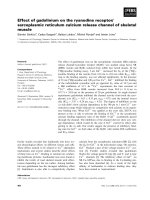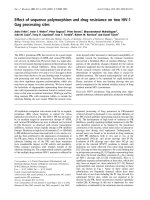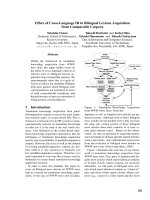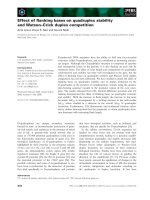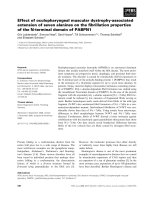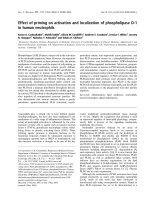Báo cáo khoa học: "Effect of yeast culture on milk production and metabolic and reproductive performance of early lactation dairy cows" docx
Bạn đang xem bản rút gọn của tài liệu. Xem và tải ngay bản đầy đủ của tài liệu tại đây (295.89 KB, 7 trang )
BioMed Central
Page 1 of 7
(page number not for citation purposes)
Acta Veterinaria Scandinavica
Open Access
Research
Effect of yeast culture on milk production and metabolic and
reproductive performance of early lactation dairy cows
Piret Kalmus*
†1
, Toomas Orro
2
, Andres Waldmann
3
, Raivo Lindjärv
4
and
Kalle Kask
1
Address:
1
Department of Therapy, Institute of Veterinary Medicine and Animal Science, Estonian University of Life Sciences, Tartu, 51014, Estonia,
2
Department of Environment and Animal Health, Institute of Veterinary Medicine nad Animal Science, Estonian University of Life Sciences, Tartu,
51014, Estonia,
3
Department of Reproductive Biology, Institute of Veterinary Medicine and Animal Science, Estonian University of Life Sciences,
Tartu 51014, Estonia and
4
Department of Infectious Diseases, Institute of Veterinary Medicine and Animal Science, Estonian University of Life
Sciences, Tartu, 51014, Estonia
Email: Piret Kalmus* - ; Toomas Orro - ; Andres Waldmann - ;
Raivo Lindjärv - ; Kalle Kask -
* Corresponding author †Equal contributors
Abstract
Background: The main objective of this study was to estimate the effect of supplementation with
Saccaromyces cerevisiae (SC) (Yea-Sacc
®
1026) on milk production, metabolic parameters and the
resumption of ovarian activity in early lactation dairy cows.
Methods: The experiment was conducted during 2005/2006 in a commercial tied-house farm with
an average of 200 milking Estonian Holstein Friesian cows. The late pregnant multiparous cows (n
= 46) were randomly divided into two groups; one group received 10 g yeast culture from two
weeks before to 14 weeks after calving. The groups were fed a total mixed ration with silages and
concentrates. Milk recording data and blood samples for plasma metabolites were taken.
Resumption of luteal activity was determined using milk progesterone (P
4
) measurements. Uterine
bacteriology and ovarian ultrasonography (US) were performed and body condition scores (BCS)
and clinical disease occurrences were recorded. For analysis, the statistical software Stata 9.2 and
R were used to compute Cox proportional hazard and linear mixed models.
Results: The average milk production per cow did not differ between the groups (32.7 ± 6.4 vs
30.7 ± 5.3 kg/day in the SC and control groups respectively), but the production of milk fat (P <
0.001) and milk protein (P < 0.001) were higher in the SC group. There was no effect of treatment
on BCS. The analysis of energy-related metabolites in early lactation showed no significant
differences between the groups. In both groups higher levels of -hydroxybutyrate (BHB) appeared
from days 14 to 28 after parturition and the concentration of non-esterfied fatty acid (NEFA) was
higher from days 1–7 post partum (PP). According to US and P
4
results, all cows in both groups
ovulated during the experimental period. The resumption of ovarian activity (first ovulations) and
time required for elimination of bacteria from the uterus did not differ between the groups.
Conclusion: Supplementation with SC had an effect on milk protein and fat production, but did
not influence the milk yield. No effects on PP metabolic status, bacterial elimination from the uterus
nor the resumption of ovarian activity were found.
Published: 3 August 2009
Acta Veterinaria Scandinavica 2009, 51:32 doi:10.1186/1751-0147-51-32
Received: 24 October 2008
Accepted: 3 August 2009
This article is available from: />© 2009 Kalmus et al; licensee BioMed Central Ltd.
This is an Open Access article distributed under the terms of the Creative Commons Attribution License ( />),
which permits unrestricted use, distribution, and reproduction in any medium, provided the original work is properly cited.
Acta Veterinaria Scandinavica 2009, 51:32 />Page 2 of 7
(page number not for citation purposes)
Background
Metabolic health is the successful adaptation of the dairy
cow for higher energy requirements and metabolic
changes during early lactation [1,2]. Many strategies, such
as direct supplementation of propylene glycol, unde-
gradable starch and monensin, have resulted in a positive
effect on glucose production, but feeding dietary fat or
specific fatty acids have not demonstrated improved
energy status [3-6].
Based on a growing concern over the use of antibiotics
and other growth promoters in the animal feed industry,
interest in the effects of microbial feed additives on ani-
mal performance has increased. Supplementation with
yeast culture has been used for over six decades and milk
production responses have been investigated by several
researchers. In some studies, cultures have improved dry
matter intake, milk yield, and milk composition [7-11]
whilst other studies have found no significant impact [12-
16]. The energy balance of dairy cows is itself a key regu-
lator of reproductive performance, changing the overall
metabolic status during the periparturient period, which
can lead to a delay in the resumption of ovarian activity
and uterine involution. It has been established recently
that the prolongation of postpartum NEB is a factor asso-
ciated with low reproductive performance in dairy cows
[17-19]. Many studies have demonstrated that the magni-
tude of NEB is related to the interval to first ovulation
[17,20]. Animals suffering from NEB will have reduced
resistance, which can lead to uterine infections and affect
the PP uterus cleansing [21].
The objective of the study was to observe if cows with bet-
ter fibre digestion and higher production values, may also
show improved concentrations of energy related metabo-
lites such as BHB and NEFA. If this is so, those animals
might have a better energy balance, which may positively
influence uterus cleaning and earlier resumption of ovar-
ian activity. Considering previously described studies,
microbial feed additives could be those substances which
can help dairy cows better adapt to lactation needs and
improve reproductive performance.
Methods
Cows and feeding
The experiment was carried out between December 2005
and May 2006 on a commercial tied-house farm with an
average of 200 milking Holstein Friesian cows. The 46 late
pregnant multiparous cows were randomly divided into
two groups before calving, and were housed in separate
rows on the farm. All cows calved during a two month
period. Ten grams of SC (Yea-Sacc
®
1026, Alltech Biotech-
nology Center, Nicolasville, YK, USA) were hand-mixed
with a small amount of concentrate and were fed daily to
each cow from the experimental group before morning
feeding, starting from two weeks before the expected calv-
ing date until 14 weeks after parturition. Ten grams of SC
is the recommended dosage according to Yea-Sacc
®
1026
instructions. The cows were fed the same total mixed
ration (TMR) diet. The TMR consisted of a grass silage and
concentrate mix. Four different silage batches were used
during the experimental period (Table 1). To control for
the effect of different silage batches on the treatment, the
feeding times of the silage batches were included in the
statistical models.
Milk production data and body condition score
During the first 90 days in milk (DIM), cow identification
number, date of calving, daily milk yield and disease
occurrence data were recorded. Cows were milked twice a
day. Every second day daily milk yield of cows was meas-
ured by automatic milking system (Milkmaster, Delaval).
The milking units were checked before commencing
recording according to DeLaval instructions.
Milk production data, including kg of milk produced, per-
centage and kg of milk fat and milk protein were recorded
by the Estonian Animal Recording Centre every second
week until 14 weeks after parturition. Body condition
scores (BCS) were recorded once per week from the day of
calving until week thirteen PP by trained personnel using
a 5-point scale (1 = thin and 5 = fat) as described by
Edmondson [22].
Collection of milk samples for progesterone analysis
Milk collection for progesterone (P
4
) analysis was col-
lected twice a week (Monday and Thursday) starting from
the second week PP until the thirteenth week. In order to
avoid the effect of the time of milk extraction on the P
4
Table 1: Chemical composition of the silages fed during the
study period.
Parameter Silage 1 Silage 2 Silage 3 Silage 4
Feeding period * 1.2.3.4.
Dry matter % 40.3 32.7 39 32.7
Crude protein% of DM 15.86 13.65 14.8 16.12
NDF % of DM 40.9 58,2 58 46.03
ADF % of DM 35.1 34.8 36.1 31.7
ME MJ/kg of DM 9.47 9.65 9.84 10.18
* Feeding period of different silages
Silage 1: 15.12.05–05.01.06
Silage 2: 06.01.06–11.02.06
Silage 3: 12.02.06–27.03.06
Silage 4: 28.03.06–20.05.06
Acta Veterinaria Scandinavica 2009, 51:32 />Page 3 of 7
(page number not for citation purposes)
concentration, samples were collected not later than 1 h
after the morning milking [23]. Milk (10 – 15 ml) was col-
lected by handstripping into plastic tubes containing
potassium dichromate as a preservative. Samples were fro-
zen at -18°C until P
4
analysis. Before analysis, milk sam-
ples were left to stand at room temperature overnight to
thaw. The following day samples were centrifuged and
concentrations of P
4
in the milk were measured by
enzyme immunoassay (EIA) according to Waldmann
[24]. The inter- and intra-assay coefficients of variation
were < 10%. The limit of sensitivity using a 20 l sample
was 0.5 ng/ml. Resumption of luteal activity was defined
as the first two consecutive measurements of P
4
concentra-
tions > 3 ng/ml. Prolonged anoestrus was determined
when consistently low P
4
concentrations were measured
for at least 50 days. [25]
Plasma metabolites
Coccygeal blood vessel samples for biochemical analysis
were collected in heparinized Venoject glass tubes (Ter-
umo Europe N. V., Leuven, Belgium) once per week dur-
ing the first 92 days PP.
After immediate centrifugation (15 min at 1048 × g),
approximately 5 ml of plasma was removed and stored at
-20°C until analysis. An automatic multiparameter ana-
lyser for clinical chemistry (EOS Bravo; Hospitex Diagnos-
tics s.r.l., Italy) was used for enzymatic determination of
plasma -hydroxybutyrate (BHB) and non-esterified fatty
acids (NEFA) with a commercially available kits (Randox
Laboratories Ltd, UK).
Collection of uterine biopsy specimen for bacteriological
examination
Each animal in the study was sampled bacteriologically
using endometrial biopsies once per week, starting within
7 days PP. Biopsy specimen collection was terminated
when at least two consecutive negative samples were
reported. In animals that only had negative samples from
the beginning of collection, sampling was terminated
after 3 weeks PP. Endometrial samples were collected
aseptically according to the techniques and methods
described previously by Kask et al.[26]. Biopsy specimens
were immediately placed in a thioglycolate medium for
transport to the Unit of Veterinary Microbiology, Estonian
University of Life Sciences, for bacteriological examina-
tion. Cultivations were made within 1.5 h after collection.
Standard bacteriological procedures according to Bergey's
Manual of Systematic Bacteriology [27] were employed.
Ultrasonographic examination of ovaries
The ultrasound (US) equipment was a real time B-mode
linear array scanner (Hondex HS-120, Honda Electronics
Co., Ltd., Aichi, Japan), with a 7.5 MHz transducer. Prints
from a videographic printer were obtained. Ultrasound
recording commenced 10 days PP and was performed
twice per week (Tuesday and Friday) until the start of reg-
ular ovarian activity. Follicular activity was monitored in
the ovaries. The sizes of the largest follicle and corpus
lutea (CL) were monitored and measured by freezing the
images and using callipers. Based on the size measure-
ments, follicular dynamics were estimated. Ovulation was
judged to have occurred if the dominant largest follicle(s)
monitored by US could not be detected at the next exam-
ination, corpus luteum development was seen during sub-
sequent examinations, and this was confirmed by a
subsequent increase in P
4
concentration [26]. All struc-
tures in the ovaries of more than 2.5 cm in diameter, and
persisted for more than 10 days, were considered to be
cysts [28].
Statistical analysis
Health data were analyzed by the Fisher Exact Test using
the statistical software Stata 9.2 [29]. Polynomial linear
random-intercept models were used to explore time trend
differences in milk production data, metabolic parameters
and BCS between the experimental and control groups.
Cows were included as random intercepts and polynomi-
als of time in increasing order from parturition in days (or
in weeks for milk fat and protein models) and their inter-
actions with treatment were added as fixed effects until
significant. Overall time trend differences between groups
were tested with the F-test. The silage ratio was controlled
in every model, and cow lactation time was included if
significant. In the milk fat and protein models, milk yield
on the sample day was used as a significant covariate. As
the time between sampling was not the same in all cows,
an isotropic spatial exponential correlation structure was
used for modelling serial correlations of repeated meas-
urements at the within-cow level in models for the meta-
bolic parameters. In models for BCS, milk constitutes and
milk yield, a first-order autoregressive (AR1) correlation
structure was used as the time between sample points
remained constant. The model assumptions were verified
by scatter and normality plots of standardized residuals
and logarithmic transformation of BHB, NEFA, BCS, and
milk fat kg were used. The NLME package [30] with statis-
tical software R 2.5.0 [31] was used for fitting these poly-
nomial linear random-intercept models.
The Cox proportional hazards model was used to explore
group differences in the timing of first rise in milk proges-
terone concentration (in weeks from parturition) and the
time when uterine bacteriological examinations were
reported to be negative (in weeks from parturition). The
statistical software Stata 9.2 [29] was used for these mod-
els.
Acta Veterinaria Scandinavica 2009, 51:32 />Page 4 of 7
(page number not for citation purposes)
Results
Clinical diseases and exclusions
Altogether seven animals were removed from the experi-
ment during the study period. Left displaced abomasum
(n = 3), rumen collapse (n = 1) and downer cow syn-
drome (n = 2) were diagnosed in the control group. One
case of downer cow syndrome was diagnosed in the exper-
imental group. Final group sizes were 22 in the experi-
mental group and 17 in the control group.
Milk production
Supplementation with SC had no statistically significant
effect on milk production over the study period. Mean (±
SEM) daily milk yield was 32.7 ± 1.39 kg/d for the exper-
imental group and 30.7 ± 5.3 kg/d for the control group.
The changes in milk yield over time are illustrated in Fig-
ure 1. From 40 days PP, the milk yield in the two groups
was similar and the curves did not differ significantly (P =
0.12). Both milk fat and protein production over time
were significantly lower in the control group (P < 0.001
and P < 0.001, respectively; Figure 2). There was no effect
of treatment on changes of BCS over time. A decrease in
BCS was seen after parturition and the lowest scores were
detected between days 56 and 63 PP in both groups (Fig-
ure 3). Figure 4 presents the changes in BHB and NEFA
during the period up to 91 days PP.
Analyses of energy-related metabolites during early lacta-
tion showed no significant differences between the
groups. An increase in BHB appeared from days 14 – 28
PP in both groups, where the decrease in NEFA stabilized
on day 21 PP.
Uterine bacteriology
In total, 234 uterine biopsies were collected from 39 cows,
where 62 (26.5%) were found to have positive bacteriol-
ogy results and the remaining 172 (73.5%) were negative.
At the beginning of lactation, biopsies from 12 cows
proved to be without bacterial growth. Of the 62 bacteri-
ologically positive samples, 12 (19.3%) showed mixed
infections and 50 (80.7%) had one of either aerobic or
anaerobic cultures. The most frequently isolated anaero-
bic bacterium was Fusobacterium necrophorum (25%)
whereas Streptococcus spp (30%) and Arcanobacterium pyo-
genes (22%) were the principal aerobic bacteria. The mean
bacterial elimination time from the uterus was the third
week in experimental group and the fourth week in the
control group. No difference was found between the
groups.
Ovarian ultrasonography and P
4
According to ovarian US, follicular activity was detected in
all cows in both groups in the first US session on day 10
PP. The US and P
4
results indicated that all cows in both
groups ovulated during the experimental period. Pro-
longed anoestrus was detected in six cows (27%) in the
experimental group and seven cows (41%) in the control
group. Knowing that ovulation occurs approximately five
days before this progesterone rise [25], the median
(range) of resumption of luteal activity (first ovulations)
was day 37 (14–93) in the experimental group and day 35
Mean daily milk yield in Saccaromyces cerevisiae and control groupFigure 1
Mean daily milk yield in Saccaromyces cerevisiae and control group. Mean (± SEM) daily milk yield during the first 90
days from parturition (measured every second day) in cows from the Saccaromyces cerevisiae group (black diamond; n = 22)
and control group (white diamond; n = 17).
0 10 20 30 40 50 60 70 80 90
20
25
30
35
40
Time (days)
Milk yield (kg)
Acta Veterinaria Scandinavica 2009, 51:32 />Page 5 of 7
(page number not for citation purposes)
(9–112) in the control group. Before the onset of ovula-
tion, regular ovarian activity (follicular waves with domi-
nant follicle appearance and regression) was detected in
both groups. The occurrence of ovarian cysts during the
first four weeks PP was detected in five (22.7%) animals
in the experimental group and four (23.5%) animals in
the control group. There were no statistical differences
between the groups.
Discussion
Milk yield and composition
Although not statistically significant, this equates to cows
receiving SC having numerically higher (5.8%) milk yield
than the controls. However, the sample size in the current
study was very small to achieve significance for such
numerical increases. Many studies have also reported an
increase in milk yield, but again the effects have not been
significant [32-36]. Some trials have noted a response to
yeast supplementation only in early lactation cows
[7,9,36]. Our study also showed that the largest difference
between the groups appeared during the first six weeks PP.
Nocek et al. [37,38] reported increased milk fat and pro-
tein percentages when direct-fed microbial product was
supplemented. We also found an impact of yeast supple-
mentation on the milk protein and fat components, espe-
cially during early lactation. An explanation for the higher
milk protein content in the experimental group could be
the well-known impact of yeast on rumen fermentation
and nutrient digestibility which enhances ammonia
uptake and improves microbial protein production
[8,39,40]. Increased milk fat percentage in very early lac-
tation is often associated with adverse events such as
excessive negative energy balance, rapid mobilization of
body fats, and subclinical ketosis. However, neither mean
blood BHB concentration nor the proportion of cows
with elevated BHB concentrations increased in the experi-
mental group. Similarly an effective digestion of fiber, in
the form of neutral detergent fibre (NDF), will increase
the number of cellulolytic bacteria in the rumen [41] and
this could also influence milk fat content. For example,
yeast supplementation had a significant effect on milk fat
and protein content when NDF in the ration was 21%
compared with 17% [42]. However, a lack of response in
milk fat in many studies [8,12,13,15] could be indicative
that the stimulation of fibre-digesting ruminal bacteria
was sufficient for milk fat synthesis in those experiments.
Mean daily milk fat and protein production in Saccaromyces cerevisiae and control groupFigure 2
Mean daily milk fat and protein production in Sacca-
romyces cerevisiae and control group. Mean (± SEM)
daily milk fat (above) and milk protein (below) during the first
14 weeks from parturition (measured every second week) in
cows from the Saccaromyces cerevisiae group (; n = 22)
and control group (
◊; n = 17).
0 2 4 6 8 10 12 14
1.0
1.2
1.4
1.6
1.8
Time (weeks)
Milk fat (kg)
0 2 4 6 8 10 12 14
0.8
0.9
1.0
1.1
1.2
1.3
Time (weeks)
Milk protein (kg)
Mean body condition score in Saccaromyces cerevisiae and control groupFigure 3
Mean body condition score in Saccaromyces cerevi-
siae and control group. Mean (± SEM) body condition
score during the first 13 weeks from parturition (measured
weekly) in cows from the Saccaromyces cerevisiae group
(black diamond; n = 22) and control group (white diamond; n
= 17).
0 1 2 3 4 5 6 7 8 9 10 11 12 13
2.5
3.0
3.5
4.0
4.5
Time (weeks)
Body condition score
Acta Veterinaria Scandinavica 2009, 51:32 />Page 6 of 7
(page number not for citation purposes)
Metabolic parameters
Several factors including BCS, NEFA, the fat/protein ratio
in milk, and ketone bodies have been found to be suitable
parameters for indirect detection of energy balance.
[21,43,44]. Milk from cows in the experimental group
consisted of more protein and fat, which could indicate
that stable rumen health may improve energy consump-
tion PP and prevent serious metabolic changes. Elevated
BHB levels suggest that fatty acids are being oxidized and
that cows may be in a more severe state of negative energy
balance [45], but no differences were found in our study.
We found a higher concentration of NEFA around the
time of calving in both groups, but subsequently stabilisa-
tion in concentrations was seen in the third week PP. The
same findings have been described by other studies
[37,38,46]
Reproductive performance
Negative energy balance may affect ovarian activity by
decreasing LH pulsativity, which leads delayed resump-
tion of luteal activity [47]. Uterine infections have also
been reported as risk factors for delayed ovulation [48]. To
rule out endometritis as a possible cause for delayed ovu-
lation, bacterial elimination time was investigated.
In our study, both groups showed a similar resumption of
ovarian activity. Previous studies where direct-fed micro-
bials [46,49] were used, also had no effect on reproductive
function.
However, a large field study with a greater number of cows
and herds is needed to determine the influence of yeast
culture supplementation on reproductive performance.
Conclusion
Based on the results of this investigation, supplementa-
tion with SC had an effect on milk protein and fat produc-
tion, but did not influence the milk yield. No effect on PP
metabolic status, bacterial elimination from uterus nor
the resumption of ovarian activity were found.
Competing interests
The authors declare that they have no competing interests.
Authors' contributions
PK carried out the study, compiled the results and drafted
the manuscript. TO participated in designing the study
and statistical analysis of the data. AW participated in data
collection and coordinated laboratory analysis, RL per-
formed bacteriological analysis and KK coordinated the
study. All authors were significantly involved in designing
the study, interpreting data and composing the manu-
script.
Acknowledgements
The Estonian Science Foundation is acknowledged for financial support
(grant No 5733, 6065 and 7891) and Alltech Biotechnology Center, Nico-
lasville, YK, USA (Trial Number 05-E-1434) for supplying the yeast culture
product used in the trial.
References
1. Goff JP, Horst RL: Physiological Changes at Parturition and
Their Relationship to Metabolic Disorders 1,2. J Dairy Sci 1997,
80:1260-1268.
2. Overton TR, Waldron MR: Nutritional Management of Transi-
tion Dairy Cows: Strategies to Optimize Metabolic Health. J
Dairy Sci 2004, 87:E105-E119.
3. Phipps RH, Wilkinson JID, Jonker LJ, Tarrant M, Jones AK, Hodge A:
Effect of monensin on milk production of Holstein-Friesian
dairy cows. J Dairy Sci 2000, 83:2789-2794.
4. Stokes SR, Goff JP: Evaluation of calcium propionate and pro-
pylenglycol administered into the oesophagus at calving.
Prod Anim Sci 2001, 17:115-122.
Mean daily -hydroxybutyrate and non-esterified fatty acid concentrations in the Saccaromyces cerevisiae and in the control groupFigure 4
Mean daily -hydroxybutyrate and non-esterified
fatty acid concentrations in the Saccaromyces cerevi-
siae and in the control group. Mean (± SEM) daily -
hydroxybutyrate(BHB) concentrations (above) and non-
esterified fatty acid (NEFA) concentrations (below) during
the first 13 weeks from parturition (data pooled by sample
week) in cows from the Saccaromyces cerevisiae group (; n
= 22) and control group (
◊; n = 17).
0 1 2 3 4 5 6 7 8 9 10 11 12 13
0.25
0.50
0.75
1.00
Time (weeks)
BHB (mmol/l)
0 1 2 3 4 5 6 7 8 9 10 11 12 13
0.00
0.25
0.50
0.75
Time (weeks)
NEFA (mmol/l)
Acta Veterinaria Scandinavica 2009, 51:32 />Page 7 of 7
(page number not for citation purposes)
5. Pickett MM, Piepenbrink MS, Overton TR: Effects of propylengly-
col or fat drench on plasma metabolites, liver composition,
and production of dairy cows during the periparturient
period. J Dairy Sci 2003, 86:2113-2121.
6. Juchem SO, Santos FAP, Imaizumi H, Pires AV, Barnabé EC: Produc-
tion and blood parameters of Holstein cows treated prepar-
tum with sodium monensin or propylene glycol. J Dairy Sci
2004, 87:680-689.
7. Wohlt JE, Finkelstein AD, Chung CH: Yeast culture to improve
intake, nutrient digestibility, and perfomance by cattle dur-
ing early lactation. J Dairy Sci 1991, 74:1395.
8. Erasmus LJ, Botha BM, Kistner A: The effects of yeast culture
supplement on production, rumen fermentation and duode-
nal nitrogen flow in dairy cows. J Dairy Sci 1992, 75:3056.
9. Robinson PH, Garret JE: Effect of yeast culture (Saccaromyces
cerevisiae) on adaptation of cows to postpartum diets and
on lactatational perfomance. J Animal Sci 1999, 77:988-999.
10. Huber JT, Sullivan J, Taylor B, Burgos A, Cramer S: Effect of feeding
Yea-Sacc on milk production and related responses in a
commercial dairy herd in Arizona. In Biotechnology in the Feed
Industry Volume 5. Alltech Technical Publications, Nicholasville, KY;
1989.
11. Williams PE, Tait CA, Innes GM, Newbold CJ: Effects of the inclu-
sion of yeast culture (Saccharomyces cerevisiae plus growth
medium) in the diet of dairy cows on milk yield and forage
degradation and fermentation patterns in the rumen of
steers. J Animal Sci 1991, 69:3016-26.
12. Swartz DL, Muller LD, Rogers GW, Varga GA: Effects of yeast cul-
tures on performance of lactating dairy cows: A field study.
J Dairy Sci 1994, 77:3073-3080.
13. Soder KJ, Holden LA: Dry matter intake and milk yield and
composition of cows fed yeast prepartum and postpartum. J
Dairy Sci 1999, 82:605-610.
14. Schingoethe DJ, Linke KN, Kalscheur KF, Hippen AR, Rennich DR,
Yoon I: Feed efficiency of mid-lactation dairy cows fed yeast
culture during summer. J Dairy Sci 2004, 87:4178-4181.
15. Arambel MJ, Kent BA: Effect of yeast culture on nutrient digest-
ibility and milk yield response in early- to mid-lactation dairy
cows. J Dairy Sci 1990, 73:1560-1563.
16. Henics Z, Combos S: Effects of yeast culture on milk produc-
tion, feed digestibility and ruminal fermentaion of dairy cat-
tle. In Biotechnology in the Feed Industr Volume 8. Alltech Technical
Publication, Nicholasville, KY; 1992.
17. Beam SW, Butler WR: Energy balance and ovarian follicle
development prior to the first ovulation postpartum in dairy
cows receiving three levels of dietary fat. Biology of Reproduction
1997, 56:133-142.
18. Staples CR, Burke JM, Thatcher WW: Influence of supplemental
fats on reproductive tissues and performance of lactating
cows. J Dairy Sci 1998, 81:856-871.
19. Butler ST, Pelton SH, Butler WR: Energy balance, metabolic sta-
tus, and the first postpartum ovarian follicle wave in cows
administered propylene glycol. J Dairy Sci 2006, 89:2938-2951.
20. Zurek E, Foxcroft GR, Knenelly JJ: Metabolic status and interval
to first ovulation in postpartum dairy cows. J Dairy Sci 1995,
78:1909-1920.
21. Suriyasathaporn W, Nielen M, Dieleman SJ, Brand A, Noordhuizen-
Stassen EN, Schukken YH: A cox proportional hazard model
with time dependent covariates to evaluate the relationship
between body condition score and the risks of first insemina-
tion and pregnancy in a high-producing dairy herd. American
Journal of Preventive Medicine 1998, 37:159-172.
22. Edmondson AJ, Lean IJ, Weaver LD, Farver T, Webster G: A body
condition scoring chart of Holstein dairy cows. J Dairy Sci 1989,
72:68-78.
23. Waldmann A, Ropstad E, Landsverk K, Sørensen K, Sølverød L, Dahl
E: Level and distribution of progesterone in bovine milk in
relation to storage in the mammary gland. Animal Reproduction
Science 1999, 56:79-91.
24. Waldmann A: Monoclonal antibodies to progesterone: charac-
terization and selection for enzyme immunoassay in bovine
milk. Hybridoma 1999,
18(3):289-296.
25. Opsomer G, Coryn M, Deluyker H, de Kruif A: An Analysis of
Ovarian Dysfunction in High Yielding Dairy Cows After Calv-
ing Based on Progesterone Profiles. Reprod Dom Anim 1998,
33:193-204.
26. Kask K, Kurykin J, Lindjärv R, Kask A, Kindahl H: Assessment of
early postpartum reproductive perfomance in two high pro-
ducing Estonian dairy herds. Acta Vet Scan 2003, 44:131-134.
27. Holt JG, Krieg NR, Sneath PH, Statley JT, Williams ST: Bergys's manual
of Determinative Bacteriology 9th edition. Williams and Wilkins Co, Bal-
timore; 1994.
28. Roberts SJ: Veterinary Obstetrics and Genital Diseases. In The-
riogenology 3rd edition. Edwards Brothers, Inc. Ann Arbor, Michigan;
1986.
29. Stata 9.2. 2005 Stata® Statacorp LP, College Station, USA.
30. Pinheiro J, Bates D, Debroy , Sarhar D: Linear and nonlinear
mixed effect models. R package version 3.1-73 2006.
31. R-soft. R Development Core Team R: A language and environ-
ment for statistical computing. R Foundation for Statistical
Computing, Vienna, Austria; 2006.
32. Erdman RA, Sharma BK: Effect of yeast culture and sodium
bicarbonate on milk yield and composition in dairy cows. J
Dairy Sci 1989, 72:1929.
33. Bernard JK: Influence of supplemental yeast on the perform-
ance of Holstein cows during early lactation. J Dairy Sci 1992,
75(Suppl 1):312.
34. Kung L, Kreck EM Jr, Tung RS, Hession AO, Sheperd AC, Cohen MA,
Swain HE, Leedle JAZ: Effects of a live yeast culture and
enzymes on in vitro ruminal fermentation and milk produc-
tion of dairy cows. J Dairy Sci 1997, 80:2045-2051.
35. Robinson PH: Effect of yeast culture (Saccharomyces cerevi-
siae) on adaptation of cows to diets postpartum. J Dairy Sci
1997, 80:1119-1125.
36. Dann HM, Prockley JR, McCoy GC, Hutjens MF, Garret JE: Effects
of yeast cultures (Saccharomyces cerevisiae) on prepartum
intake and postpartum intake and milk production of Jersey
cows. J Dairy Sci 2000, 83:123-127.
37. Nocek JE, Kautz WP, Leedle JA, Block E: Direct-fed microbial sup-
plementation on the performance of dairy cattle during the
transition period. J Dairy Sci 2003, 86:331-335.
38. Nocek JE, Kautz WP: Direct-fed microbial supplementation on
ruminal digestion, health, and performance of pre-and post-
partum dairy cattle. J Dairy Sci 2006, 89:260-266.
39. Harris B Jr, Webb DW: The effect of feeding a concentrated
yeast culture product to lactating dairy cows. J Dairy Sci 1990,
73(Suppl 1):266.
40. Miller-Webster T, Hoover WH, Holt M: Influence of yeast culture
on ruminal microbial metabolism in continuous culture. J
Dairy Sci 2002, 85:2009-2014.
41. Dawson KA, Newman KE, Boling JA: Effects of microbial supple-
ments containing yeast and lactobacilli on roughage-fed
ruminal microbial activities. J Animal Sci 1990, 60:3392.
42. Wang Z, Eastridge ML, Qiu X: Effects of forage neutral deter-
gent fiber and yeast culture on performance of cows during
early lactation. J Dairy Sci 2001, 84:204-212.
43. Rukkwamsuk T, Wensing T, Geelen MJ: Effect of overfeeding dur-
ing the dry period on regulation of adipose tissue metabo-
lism in dairy cows during the periparturient period. J Dairy Sci
1998, 81:2904-2911.
44. Le Blanc S: Monitoring programs for transition dairy cows.
proceedings of the World Buiatric Congress, Nice, France;
2006:460-471.
45. Lean IJ, Farver TB, Trout ML, Bruss JC, Galland R, Baldwin L, Holm-
berg CA, Weaver LD: Time series cross-correlation analysis of
postparturient relationships among serum metabolites and
yield variables in Holstein cows. J Dairy Sci 1992, 75:1891-1898.
46. Francisco CC, Chamberlain CS, Waldner DN, Wettemann RP, Spicer
LJ: Propionibacteria fed to dairy cows. Effects on energy bal-
ance, plasma metabolites and hormones, and reproduction.
J Dairy Sci 2002, 85:1738-1751.
47. Opsomer G, Gröhn YT, Hertl J, Coryn M, Deluyker H, de Kruif A:
Risk factors for post partum ovarian dysfunction in high pro-
ducing dairy cows in Belgium: a field study. Theriogenology
2000, 53:
841-857.
48. Mateus L, da Costa LL, Bernardo F, Silva JR: Influence of puerperal
uterine infection on uterine involution and postpartum ovar-
ian activity in dairy cows. Reprod Domest Anim 2002, 37:31-35.
49. Stein DR, Allen DT, Perry EB, Bruner JC, Gates KW, Rehberger TG,
Mertz K, Jones D, Spicer LJ: Effects of Feeding Propionibacteria
to Dairy Cows on Milk Yield, Milk Components, and Repro-
duction. J Dairy Sci 2006, 89:111-125.



